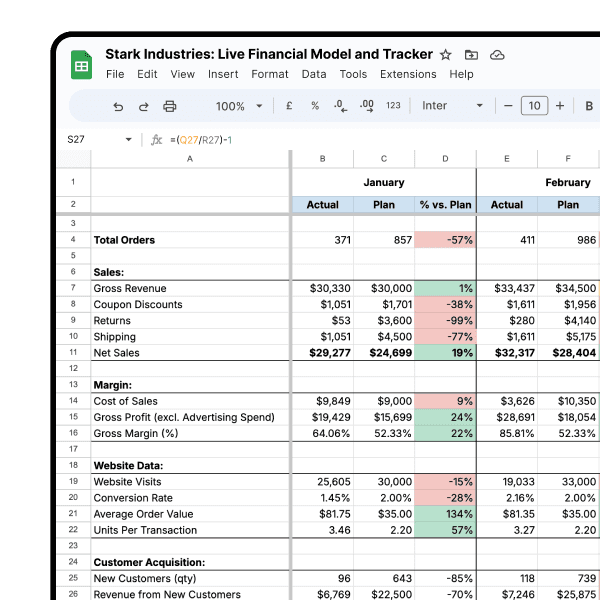Best Practices
Mar 28, 2025
TLDR
Automated spreadsheets and AI are replacing slow, error-prone manual reporting, streamlining data collection and analysis with real-time insights and cost optimization. These tools reduce human error, enhance efficiency, and scale effortlessly, empowering businesses with predictive AI-driven insights for better decision-making. Despite challenges like integration and training, adopting automation is essential for staying competitive in a data-driven world.
A long time businesses used manual reporting to track performance, analyze finances, and make decisions. But as data grows more complex, this approach has become slow, error-prone, and inefficient. Automated spreadsheets and AI-driven analytics are changing the game by making data collection and analysis faster and more accurate. These tools reduce workload, minimize mistakes, and provide real-time insights for better decision-making.
Manual spreadsheets require constant updates and verification, taking up valuable time. AI-powered tools automate the process by gathering data, spotting trends, and generating reports instantly. Companies using automation are already seeing better efficiency, cost savings, and improved accuracy.
Automation is key in cost analysis. AI-driven tools help businesses track dedicated server hosting costs, compare providers, and predict expenses. By analyzing real-time pricing and past spending, AI-powered spreadsheets eliminate manual work and provide insights to optimize IT budgets.
Advantages of Automated Spreadsheets and AI in Data Collection
Efficiency & Time Savings
Traditional reporting involves multiple steps, including data entry, cleaning, validation, and visualization. Automated spreadsheets reduce the time spent on these tasks by integrating with various data sources and updating information in real time. AI further enhances efficiency by automatically detecting anomalies, identifying patterns, and offering predictive insights.
Reduced Human Error
Human errors in data reporting can lead to costly mistakes and misinformed decisions. Automated tools eliminate common issues such as miscalculations, incorrect data entry, and formula errors. AI-driven validation processes ensure that anomalies and inconsistencies are flagged before reports are finalized.
Real-Time Data Access & Analysis
Businesses no longer have to wait for end-of-month reports to analyze trends. AI-driven tools offer real-time data monitoring, allowing organizations to react instantly to market changes, operational inefficiencies, or customer demands. This is particularly beneficial for industries such as finance, e-commerce, and logistics, where timely insights can lead to better profitability and customer satisfaction.
Scalability
As companies grow, so does the complexity of their data. Manual reporting struggles to keep up with large datasets, often requiring additional personnel to manage the workload. Automated solutions, on the other hand, scale seamlessly, handling vast amounts of data across multiple departments without compromising accuracy or efficiency.
Cost Optimization
AI-powered reporting tools can help businesses optimize costs by identifying inefficiencies, unnecessary expenditures, and potential savings. For instance, tracking dedicated server hosting costs over time allows companies to identify the most cost-effective hosting providers, negotiate better contracts, and eliminate underutilized resources.
AI-Driven Insights: The Future of Decision Making
The role of AI in data analysis extends beyond automation; it provides deeper insights that empower strategic decision-making. Machine learning algorithms can analyze historical data to predict future trends, detect correlations that humans might overlook, and generate recommendations tailored to specific business needs.
For example, e-commerce companies use AI-powered reporting tools to analyze customer purchasing behavior, forecast inventory demand, and personalize marketing strategies. Financial institutions leverage AI-driven insights to assess risk, detect fraud, and improve investment strategies. The ability to make data-driven decisions with minimal human input is transforming industries and driving significant competitive advantages.
Overcoming Challenges in AI-Driven Automation
While the benefits of automated spreadsheets and AI in data collection are undeniable, businesses must also address certain challenges:
Integration with Existing Systems
Many organizations rely on legacy systems that may not be compatible with modern AI-driven tools. Transitioning to automated solutions requires careful planning and integration strategies.
Data Security & Compliance
With increased automation comes the responsibility of securing sensitive data.
Employee Training & Adoption
Introducing AI-powered tools requires training employees to understand and utilize them effectively. A smooth transition is essential to maximizing the benefits of automation.
Improve your DTC game. Sign up for weekly tips.
Conclusion
The era of manual reporting is coming to an end. Automated spreadsheets and AI-driven analytics are transforming the way businesses collect, process, and interpret data. From reducing human error and enhancing efficiency to enabling real-time decision-making and cost optimization, the benefits of automation are substantial. Companies that leverage AI-powered reporting tools can stay ahead of the competition, optimize operations, and unlock new growth opportunities. The key to success lies in embracing this technological evolution and adapting to a data-driven future.

